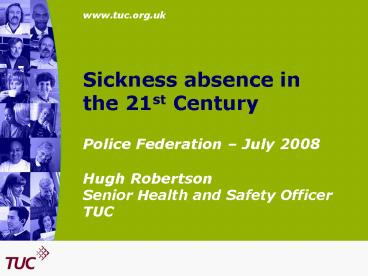Sickness absence in the 21st Century - PowerPoint PPT Presentation
1 / 10
Title:
Sickness absence in the 21st Century
Description:
Scale of the problem. 165 million working days lost every year. ... Must not be done in a patronising manner. Workforce involvement ... – PowerPoint PPT presentation
Number of Views:100
Avg rating:3.0/5.0
Title: Sickness absence in the 21st Century
1
Sickness absence in the 21st Century
- Police Federation July 2008
- Hugh Robertson
- Senior Health and Safety Officer
- TUC
2
Scale of the problem
- 165 million working days lost every year.
- 36 million have an occupational cause
- 2.2 million suffering from an illness they
believed was caused or made worse by work - Average worker takes 7 days off a year steady
fall - Sickness absence rates have fallen consistently
over past 10 years - European comparisons difficult but UK levels
probably among lowest in Europe - Public private split
- CBI puts cost for employers at 13 billion
3
Reasons for absence
- Record keeping very bad (reasons)
- 2/3 of days are short term minor illnesses.
- Remainder either recurring or serious long term
illnesses - Stress now single largest cause of long-term
- Relationship with lifestyle issues (smoking,
diet, exercise, drugs and alcohol)
4
Sickness absence issues (1)
- More presenteeism than absenteeism
- No evidence of widespread abuse
- Different approach to long and short term (short
term often cultural) - Relationship between physical and psychological
factors - Either too ill to work or perfectly well
5
Sickness absence issues (2)
- Interventions limited by funding
- Little access to rehabilitation
- Little link with prevention
- 1/3 of absence caused by work
- Interventions often based on fear of compensation
claims (so employers concentrate on work-related)
6
Traditional response
- Sanctions (pay, or promotion)
- Incentives
- Reduce sickness absence by concentrating on
worker not the cause - Where absence likely to be long term early
retirement.
7
Positive response
- Focus on prevention
- Return to work policies
- Keeping in touch
- Access to occupational health services and early
rehabilitation - Adjustments to enable return to work
- Recuperative duties (rather than restrictive)
- Help to support and empower workers
8
Approaching Lifestyle issues
- There is a role for employers gyms, canteens,
etc. - Must not be done in a patronising manner
- Workforce involvement
- Must concentrate on the relationship with the
workplace (worklife balance, stress, transport
etc) - Not a substitute for prevention Yoga for stress
etc) - No actual evidence workplace health promotion is
effective
9
Evidence base for Sickness absence
- Simple focusing on attitudes does not work
- Incentives and sanctions can both backfire
- Rehab works in some cases but little info on for
what and when - Early access to physios does seem to help for
MSDs - CBT including group interventions can be
effective - Early interventions by managers does work
- Prevention is more effective than sickness
absence - Involving workforce/representatives has a
considerable effect
10
Agenda for change
- Universal access to OH provision
- Employers need to have a policy framework for
dealing with sickness absence - Better training and support for GPs
- Changes to benefits system to encourage phased
return to work and prevent transfer of
responsibility to state - Legal right to rehabilitation
- Work should be adapted to the worker, not the
other way around

